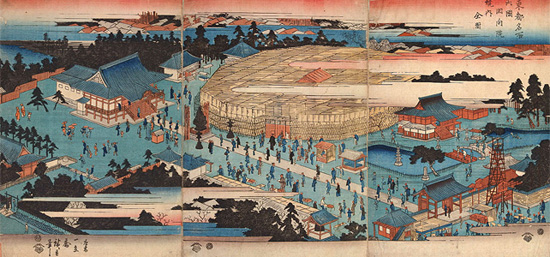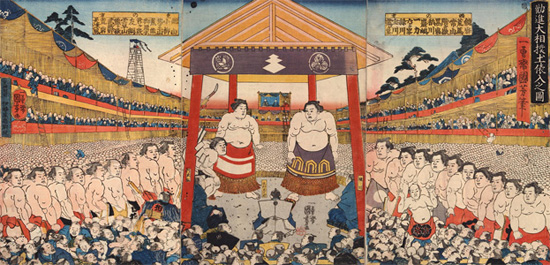Great-Edo Entertainment
Kabuki Special / Grand Sumo Special / Rakugo SpecialThe Emergence of Kanjin Zumō Tournaments (Ōzumō)
(Tōto Meisho Ryōgoku Ekoin Keidai Zenzu)
Painted by Utagawa Hiroshige 1842 (Tempō 13)
Kanjin zumō (public sumō bouts) was originally held as a fundraiser for Buddhist temples to raise money for constructing or repairing their buildings such as halls and gates. The tradition of kanjin zumō began sometime during the Sengoku period, and it was held nationwide but mainly in Kyōto, Ōsaka, and Edo at an early stage of the Tokugawa Shogunate. However, in the mid-17th century, sumō performances in public were prohibited by the government even as a fundraiser of temples, being blamed for disturbing public morals. Nevertheless, the popularity of sumō did not fade, and as a form of dohyō (ring) was newly invented, the Edo government switched its policy to permit and support the kanjin zumō in the Genroku period.
At first, the resumed kanjin zumō tournaments were held for eight consecutive sunny days at various locations throughout the town of Edo, including Tomioka Hachiman Shrine(Tomioka Hachiman-gū)in Fukagawa, Ekōin Temple in Honjo, and Yushima Tenjinja Shrine in Yushima. At this point, Ekōin Temple was merely one of many venues, but more tournaments began to concentrate at the temple during the Tenmei years. Eventually, after 1833 (Tempō 4), Ekōin served as the only venue of the sumō tournaments in Edo. Sumō became even more popular among people in Edo during the Tenmei through Kansei years when superstar wrestlers such as Tanikaze, Onogawa, and Raiden were active. It is also believed that the tournaments began to be called Kanjin ōzumō during this time.
There were no dedicated buildings for sumō in the Edo period, and the tournaments took place at a hut sheltered with marsh-reed screens, which was temporarily built in the grounds of temples and shrines. It was a huge structure that offered both second and third-floor seating for spectators. This allowed for a large crowd to enjoy watching their favorite wrestlers in action. Women were prohibited from the venue and this ban was only lifted after the Meiji era (1868).
* To view more explanation, please click the each image.



